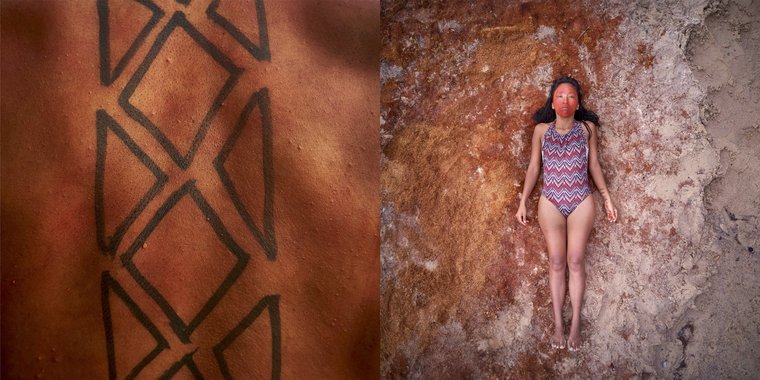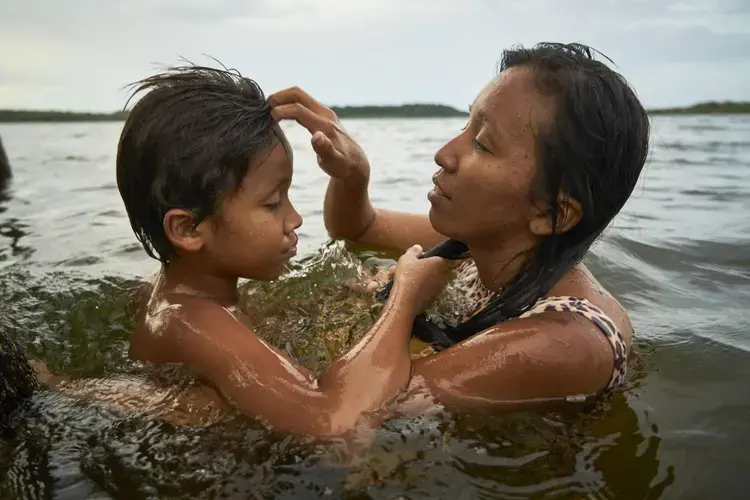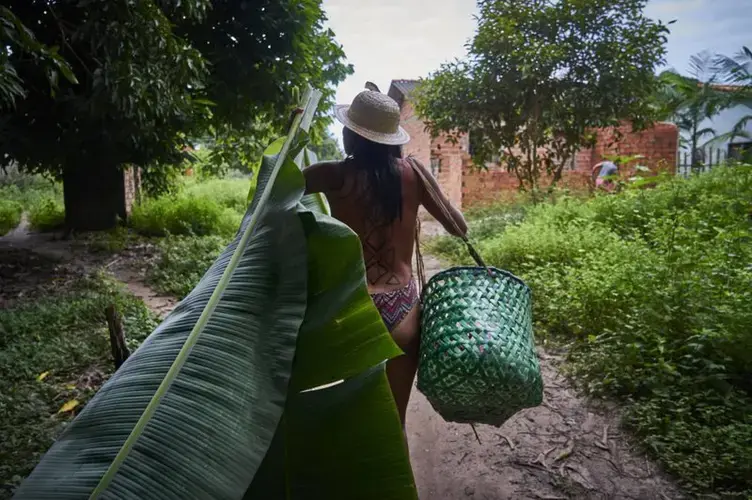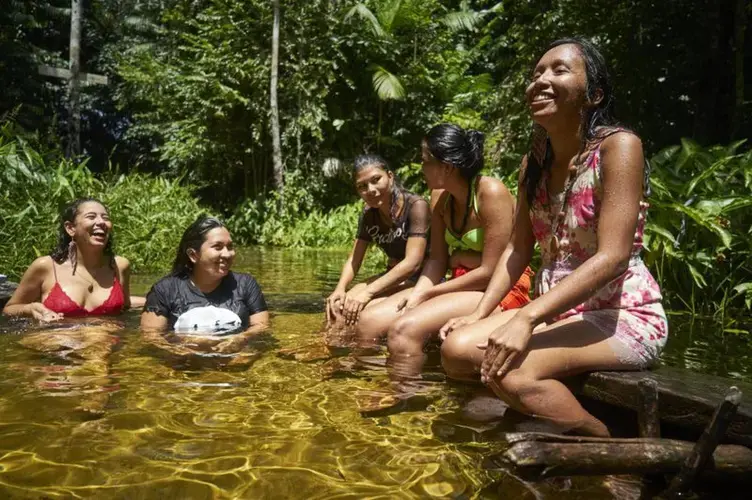
Just as scars accumulate on the bark of the seringueiras (rubber trees, Hevea Brasiliensis) throughout the Amazon, so do natives who carry deep wounds on their bodies, dating far back in time.
The first industrial threat on a catastrophic scale that befell the Amazon was the Rubber Fever (1879/1912), which burst onto these remote lands and broke the fragile balance between human beings and the exuberant nature of the forest, which had been reached through a many centuries effort at adaptation and symbiosis. The massive extraction of rubber entailed the abuse, the enslavement, and even the extermination of entire indigenous villages.
Today, among the settlers who live on the banks of the Tapajós River and its tributaries, one can see the huge, widespread damage that the industrial extraction of their rich natural resources brought to their original way of life. Modernity caused the collapse of the balanced ecosystem in this fertile and wild land.
It was never easy to live here. Despite the devastating impact of colonization, the native peoples adapted to a harsh but habitable environment and managed to keep on living in harmony with it for hundreds of years.
But the repression of revolts like the Cabanagem (1835-1840) in the Great Pará which resulted in the genocide of the Murá and Mauè peoples, threatened the survival of other Indigenous peoples and drove them to abandon their culture, their language, and their traditions, especially under the violent influence of the missionaries who confronted them with a terrible dilemma: either convert to Christianity, deny your own culture and your ancestral roots, or die.
Anthropologist Claude Levy-Strauss stated categorically, in his masterpiece Tristes Tropiques (1955), that modernity violated even the most remote Indigenous virginity. The myth of the immaculate native is a ghost that only some romantic anthropologists and clueless travelers keep on pursuing. It disappeared a long time ago, once and for all.

San Francisco, a village in the Tapajós-Arapiuns Extractive Reserve, is a good example. Here, which is where Tupí, a young Indigenous woman struggling to rebuild her life, can find an explanation for some of the wounds and the violence that persist in the Amazonian communities on the banks of the Tapajós river.
Considering the circumstances in which Tupí grew up, getting up, and standing up on her own, and steadily going forward requires exceptional courage. Tupí certainly has what it takes.
She has the courage to recover the very same harmonious relationship with the land that her grandparents and great grandparents had.
She has the courage to overcome a personal history of sexual, physical, and psychological violence by an abusive couple, who died in a motorcycle accident.
She has the courage to pull herself up by her bootstraps and educate her only child. She has the courage to build an autonomous life and to go and study in the city. She has the courage also to look herself in the mirror and assume the trauma of oppression and systematic rape.
She has the courage, finally, to face an oppressive silence, the silence that oppresses so many other women, and the weapon of constant humiliation.
Tupí has found the strength she needed by reinforcing her Indigenous identity and, at the same time, affirming her femininity. It has helped her to be able to do this together with other courageous women who are struggling like her to overcome abuse, rape, and mistreatment and achieve recognition through solidarity and collective action.
Being part of a movement, learning how to lead it, and how to build their own free space is what makes these women exceptional beings in their community.
Tupí tries to find in the land and the values of her ancestors a narrative of continuity with an admittedly mythical origin, the reason for existence of which is a most powerful one: its transmission to her son Joao.
Joao gives Tupí the energy and the passion needed to place herself in a longer historical time and feel that she is a link in a lineage.
But to face one’s daily struggle and, at the same time, to put things in context and keep looking forward, is no simple exercise. The support of other women in the community is key in making this possible. It is what turns the vulnerability of an isolated woman, a widowed mother marked by tragedy, into strength and resolve.
As it is already the case in many cities, being a woman among women who support each other is today a recurrent reality in the communities and villages along the river.
Organizing to fight has been Tupí’s anchor, which has allowed her to leave oppression behind and become someone. Participating actively in recognition and awareness-raising actions that are taking place more and more frequently is what gives meaning to both the individual and the collective struggle.
Tupí belongs to the Tapajós Surara Indigenous women collective based in Alter do Chao, on the other side of the river, some two hours away by speedboat. The trip is not always nice and safe, for it is often windswept, and hit by heavy rain.
For Tupí, being part of this group, affirming herself as a woman among women, recovering the words of her Indigenous language, sometimes through songs performed by the group of Carimbó (a popular musical rhythm of the state of Pará) that they have recently formed, has been a means of empowerment and liberation.

"I became a woman who unbuttoned herself", she says emotionally. "I did not know the strength I had stored inside. In the midst of so many things, I did not have the courage to speak, I couldn’t speak". The group has been with her all along, has comforted her, has encouraged her to take on the pain inside and to feel that she is someone again—or perhaps for the first time.
Tupí has experienced this as sheer wonder, as happiness. Feeling useful, being able to speak on behalf of other Tupinambá women who had been raped like her, and going out to do so in other areas, beyond her village, is a mission that Tupí assumes readily, even though still with some sense of insecurity.
But beyond ensuring a future for Joao, Tupí is learning how to train other women to take up the struggle for the conservation of the land and to strengthen their reconstructed Indigenous identity.
"I don’t talk about me, but about us. That's where my emotion comes from. We have a voice, and we have to defend the land." Tupí thinks that she has learned a lot in her journey towards activism and defense.
She has learned from other women, from self-learning, from the elderly, and the community teachers. Her interest in rebuilding an Indigenous voice and share it with other women, even if it is from the rubble of a world that has almost vanished, is an essential part of her struggle to survive, to resist.
But where Tupí grows and strengthens herself, where she gathers enough courage to feel truly useful to the women in her community, is in collective action. In the village of San Francisco, Tupí, and a small group of women organized a self-affirmation action.
In the late afternoon, the women staged a syncretic procession. They walked along the main "avenue" carrying two small images of two locally worshipped saints. They also carried cardboard placards with slogans against gender violence and femicide. Candles had been distributed among the participants—women and girls and some (very few) men—and, at nightfall, they set off at a slow but determined pace along the avenue.
Between religious chants, Mysteries of the Rosary, and Our Father, the procession stopped several times to shout protest slogans and demands.
With a mixture of devotion and restrained anger, they read, one by one, the slogans they had written on the placards. The Mysteries of the Rosary marked each of the stops. The village men were nowhere to be seen. As the procession passed in front of the grocery store, in a show of surprise and contempt, they barely looked.

As the procession passed, however, some doors and windows half opened and some women, carrying their babies, looked out timidly.
The procession-demonstration-conjuration progressed without knowing very well where it was heading. Each pause became an invocation. The women were well aware that they were engaged in an act of transgression of a long-established order.
The candlelight added drama, emotion and liturgy to the procession. And it evoked a magical and sacred world that once reigned in these Indigenous lands.
Above all, there was determination among these women. For they know that no one will come to help them, that the odds are high, that the task ahead requires strength and that this strength can only be had if they unite and stay together.
But nothing has ever been easy here in this afflicted land of Tupinambá. The natives have long learned that the only way to survive is to resist.
The procession ended with a symbolic action. The women drew on the ground a large bow and arrow representing the many struggles to survive: the struggle of the Indigenous people; the struggle of women; the struggle for the conservation of the land; Tupí’s struggle.
The women, the teenagers, and the girls placed their candles along the outline of the drawing on the road: an aerial shot would show the size of the symbol.
The next day, the women held an assembly in the village Indigenous school to assess the action, debate, and decide. The task ahead is going to be a hard one, but there is no turning back.
Getting the wounds of violence on their skin to heal, like the wounds in the rubber trees, is the ultimate goal of all this.
Two days later, Tupí gets together with her son in Alter do Chao, where the Suraras movement headquarters are. In that moment of mother-and-son communion, bathing in the sacred river which means so much to her, Tupí is aware that her role in this story is a role in a story of empowerment and self-improvement.
She hopes she will be joined by many more women as they come to decide, in growing numbers, to take a step forward in building their own identity as women, as natives, and as main characters in their own biography.
In this Amazonian world, engulfed in multiple threats and violence, Tupí’s is a story of courage and resolve.
This article is part of the Rainforest Defenders series, a project by democraciaAbierta in collaboration with Engajamundo Brasil. It was originally published by El País here.




